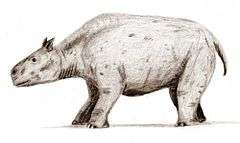Notoungulata
| Notoungulata Temporal range: Paleocene–Pleistocene | |
|---|---|
 | |
| Toxodon platensis | |
| Scientific classification | |
| Kingdom: | Animalia |
| Phylum: | Chordata |
| Class: | Mammalia |
| Infraclass: | Eutheria |
| Superorder: | †Meridiungulata |
| Order: | †Notoungulata Roth 1903 |
| Suborders and Families | |
|
See text | |
Notoungulata is an extinct order of hoofed, sometimes heavy bodied mammalian ungulates that inhabited South America during the Paleocene to Pleistocene, living from approximately 57 Ma to 11,000 years ago.[1]
Taxonomy
Due to the isolated nature of South America, many notoungulates evolved along convergent lines into forms that resembled mammals on other continents. Examples of this are Pachyrukhos, a notoungulate that evolved to fill the role of rabbits and hares, and Homalodotherium, which evolved to resemble chalicotheres. During the Pleistocene, Toxodon was the largest common notoungulate. Most of the group (Mixotoxodon and Toxodon being the exception) became extinct after the landbridge between North and South America was formed, allowing North American ungulates to enter South America in the Great American Interchange and out-compete the native fauna. This order is united with other South-American ungulates in the super-order Meridiungulata.
Cifelli has argued that Notioprogonia is paraphyletic, as it would include the ancestors of the remaining suborders. Similarly, Cifelli indicated that Typotheria would be paraphyletic if it excluded Hegetotheria and he advocated inclusion of Archaeohyracidae and Hegetotheriidae in Typotheria.[2]
As reflected in the map that accompanies this article, Notoungulata were for many years taken to include the order Arctostylopida, whose fossils are found mainly in China. Recent studies, however, have concluded that Arctostylopida are more properly classified as gliriforms, and that the notoungulates were therefore never found outside South and Central America.[3]
Based on an analysis of 133 morphological characters in 50 notoungulate genera, Billet 2011 concluded that Homalodotheriidae, Leontiniidae, Toxodontidae, Interatheriidae, Mesotheriidae, and Hegetotheriidae are the only monophyletic families of notoungulates.
| Notoungulata |
| ||||||||||||||||||||||||||||||||||||||||||||||||||||||||||||||||||||||||||||||||||||||||||||||||||||||||||||||||||||||||||||||||||||||||||||||||||||||||||||||||||||||||||||||||||||||||||||||||||||||||||||||||||||||||||||||||||||||||||||||||
| |
A recent analysis using collagen sequencing found that notoungulates and litopterns are sisters to perissodactyls, making them true ungulates.[4] This conflicts with the results of some morphological analyses which favoured them as afrotherians. It is in line with some more recent morphological analyses which suggested they were basal euungulates.
Orders and families
- Order Notoungulata - notoungulates
- Suborder Notioprogonia
- Family Henricosborniidae
- Family Notostylopidae
- Suborder Toxodonta
- Family Isotemnidae
- Family Leontiniidae
- Family Notohippidae
- Family Toxodontidae
- Family Homalodotheriidae
- Suborder Typotheria
- Family Archaeopithecidae
- Family Oldfieldthomasiidae
- Family Interatheriidae
- Family Campanorcidae
- Family Mesotheriidae
- Suborder Hegetotheria
- Family Archaeohyracidae
- Family Hegetotheriidae
- Suborder Notioprogonia
References
Footnotes
- ↑ Notoungulata in the Paleobiology Database. Retrieved April 2013.
- ↑ Cifelli 1993
- ↑ Missiaen et al. 2006
- ↑ Welker et al. 2015
Notations
- Billet, Guillaume (December 2011). "Phylogeny of the Notoungulata (Mammalia) based on cranial and dental characters" (PDF). Journal of Systematic Palaeontology. 9 (4): 481–97. doi:10.1080/14772019.2010.528456. OCLC 740994816. Retrieved April 2013. Check date values in:
|access-date=(help) - Carroll, Robert Lynn (1988). Vertebrate Paleontology and Evolution. New York: W.H. Freeman and Company. ISBN 9780716718222. OCLC 14967288.
- Cifelli, Richard L (1993). "The phylogeny of the native South American ungulates". In Szalay, F.S.; Novacek, M.J.; McKenna, M.C. Mammal phylogeny: Placentals. 2. New York: Springer-Verlag. pp. 195–216. ISBN 0-387-97853-4. OCLC 715426850.
- McKenna, M.C. (1975). "Toward a phylogenetic classification of the Mammalia". In Luckett, W.P.; Szalay, F.S. Phylogeny of the primates: a multidisciplinary approach (Proceedings of WennerGren Symposium no. 61, Burg Wartenstein, Austria, July 6–14, 1974. New York: Plenum. pp. 21–46. doi:10.1007/978-1-4684-2166-8_2. ISBN 978-1-4684-2168-2. OCLC 1693999.
- McKenna, Malcolm C.; Bell, Susan K. (1997). Classification of Mammals Above the Species Level. New York: Columbia University Press. ISBN 0231110138. OCLC 37345734.
- Missiaen, P; Smith, T; Guo, DY; Bloch, JI; Gingerich, PD (August 2006). "Asian gliriform origin for arctostylopid mammals". Naturwissenschaften. 93 (8): 407–11. doi:10.1007/s00114-006-0122-1. PMID 16865388. Cite uses deprecated parameter
|coauthors=(help) - Roth, Santiago (1903). "Los Ungulados Sudamericanos". Anales del Museo de La Plata (Sección Paleontológica). 5: 1–36. OCLC 14012855.
- Welker, F.; Collins, M. J.; Thomas, J. A.; Wadsley, M.; Brace, S.; Cappellini, E.; Turvey, S. T.; Reguero, M.; Gelfo, J. N.; Kramarz, A.; Burger, J.; Thomas-Oates, J.; Ashford, D. A.; Ashton, P. D.; Rowsell, K.; Porter, D. M.; Kessler, B.; Fischer, R.; Baessmann, C.; Kaspar, S.; Olsen, J. V.; Kiley, P.; Elliott, J. A.; Kelstrup, C. D.; Mullin, V.; Hofreiter, M.; Willerslev, E.; Hublin, J.-J.; Orlando, L.; Barnes, I.; MacPhee, R. D. E. (2015-03-18). "Ancient proteins resolve the evolutionary history of Darwin's South American ungulates". Nature. doi:10.1038/nature14249. ISSN 0028-0836.